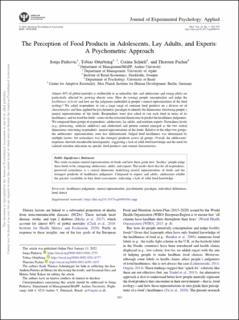| dc.contributor.author | Perkovic, Sonja | |
| dc.contributor.author | Otterbring, Anders Emil Tobias | |
| dc.contributor.author | Schärli, C | |
| dc.contributor.author | Pachur, Thorsten | |
| dc.date.accessioned | 2023-03-28T09:20:50Z | |
| dc.date.available | 2023-03-28T09:20:50Z | |
| dc.date.created | 2022-01-27T11:14:00Z | |
| dc.date.issued | 2022 | |
| dc.identifier.citation | Perkovic, S., Otterbring, A. E. T., Schärli, C. & Pachur, T. (2022). The Perception of Food Products in Adolescents, Lay Adults, and Experts: A Psychometric Approach. Journal of Experimental Psychology: Applied, 28 (3), 555-575. | en_US |
| dc.identifier.issn | 1939-2192 | |
| dc.identifier.uri | https://hdl.handle.net/11250/3060664 | |
| dc.description.abstract | Almost 40% of global mortality is attributable to an unhealthy diet, and adolescents and young adults are particularly affected by growing obesity rates. How do (young) people conceptualize and judge the healthiness of foods and how are the judgments embedded in people’s mental representations of the food ecology? We asked respondents to rate a large range of common food products on a diverse set of characteristics and then applied the psychometric paradigm to identify the dimensions structuring people’s mental representations of the foods. Respondents were also asked to rate each food in terms of its healthiness, and we used the foods’ scores on the extracted dimensions to predict the healthiness judgments. We compared three groups of respondents: adolescents, lay adults, and nutrition experts. Naturalness levels (e.g., processing, artificial additives) and cholesterol and protein content emerged as the two central dimensions structuring respondents’ mental representations of the foods. Relative to the other two groups, the adolescents’ representations were less differentiated. Judged food healthiness was determined by multiple factors, but naturalness was the strongest predictor across all groups. Overall, the adolescents’ responses showed considerable heterogeneity, suggesting a lack of solid food knowledge and the need for tailored nutrition education on specific food products and content characteristics. | en_US |
| dc.language.iso | eng | en_US |
| dc.publisher | American Psychological Association (APA) | en_US |
| dc.rights | Attribution-NonCommercial-NoDerivatives 4.0 Internasjonal | * |
| dc.rights.uri | http://creativecommons.org/licenses/by-nc-nd/4.0/deed.no | * |
| dc.title | The perception of food products in adolescents, lay adults, and experts: A psychometric approach | en_US |
| dc.type | Peer reviewed | en_US |
| dc.type | Journal article | en_US |
| dc.description.version | publishedVersion | en_US |
| dc.rights.holder | © 2022 American Psychological Association | en_US |
| dc.subject.nsi | VDP::Samfunnsvitenskap: 200::Psykologi: 260 | en_US |
| dc.source.pagenumber | 555-575 | en_US |
| dc.source.volume | 28 | en_US |
| dc.source.journal | Journal of Experimental Psychology: Applied | en_US |
| dc.source.issue | 3 | en_US |
| dc.identifier.doi | https://doi.org/10.1037/xap0000384 | |
| dc.identifier.cristin | 1991132 | |
| dc.description.localcode | Paid open access | en_US |
| cristin.qualitycode | 1 | |

